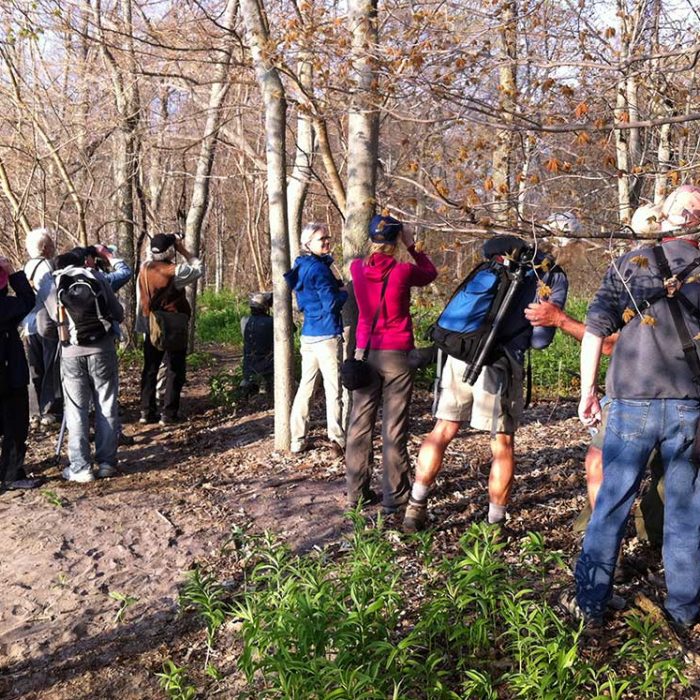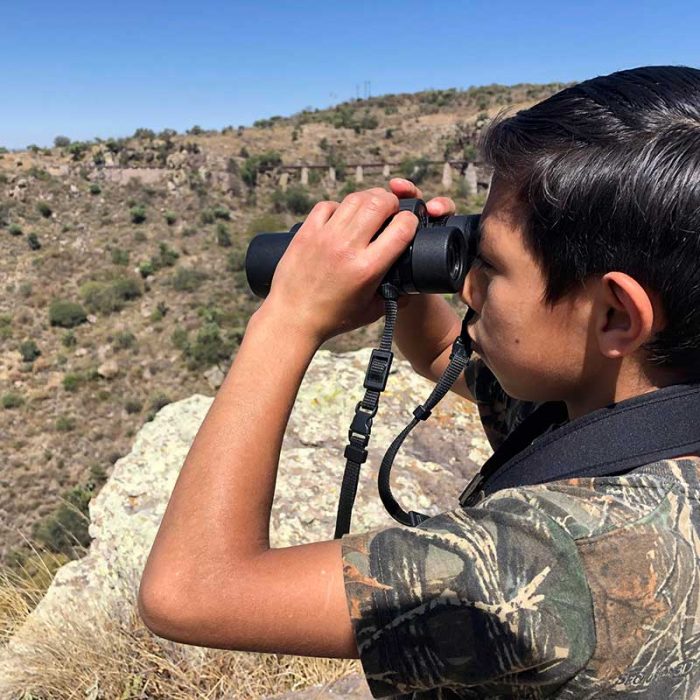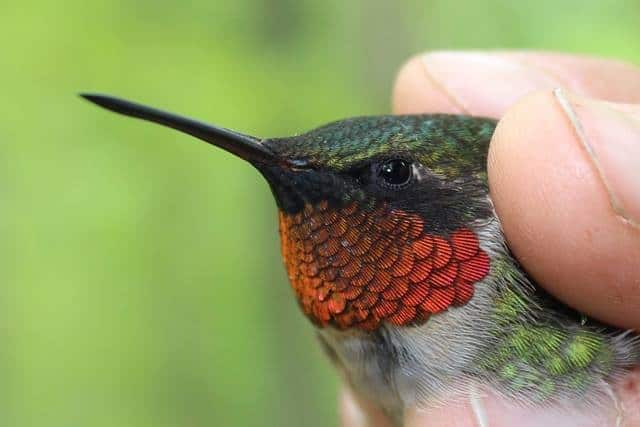Eastern Bluebird. Photo by Sumiko Onishi
PIBO’s field staff began the month of November eager to continue bird banding, but the weather had other plans. Rain on both November 1st and 2nd prevented the nets from being opened, though the daily census recorded plenty of birds. The west beach at Fish Point hosted many different species of sparrows, including Slate-coloured Juncos and White-throated, Chipping, Field and Song Sparrows, and several Common Terns were seen on November 1st, sculling unconcernedly into the strong east wind and plunging into the waves to strike at unwary fish. On November 6th, thousands of Common Grackles and Rusty Blackbirds filled the bare branches of the trees around Fox Pond before lifting up out of the trees and coalescing into a tight flock to protect themselves from five Northern Harriers that hove suddenly into view. Most of the Harriers dismissed them as unworthy of attention: but one juvenile couldn’t resist and persistently chased the flock back and forth above the pond, without success. Over a hundred American Goldfinches were seen as well, looking like milkweed pods as they clung to the dried stalks of wildflowers.
November 3rd dawned dark and overcast, but the skies eventually cleared. The mist-nets were opened, and scooped up 72 birds – a very good total for so late in the year! Most of the birds banded were Golden-crowned Kinglets, Ruby-crowned Kinglets, White-throated Sparrows and American Goldfinches; a few Hermit Thrushes and two Blue-headed Vireos were banded as well, and the season’s first Golden Eagle was observed flying over the netting area. More Golden-crowned Kinglets were banded on November 4th, but the gusting winds made it impossible to keep the nets open for long. A female Rose-breasted Grosbeak was seen on census near the tip of Fox Pond, whisper-singing.
The strong south winds continued over the next few days, and bird migration slowed accordingly. 32 out of the 39 birds banded on November 5th were Golden-crowned Kinglets, and seven of the birds captured were birds that had been banded by PIBO a day or two before. On November 6th, the blustery conditions meant that nets could only be opened for an hour and a half in total. The wind came gusting out of the southwest and kicked up the waves on the west side of Fish Point so much that the west beach was almost gone by the time PIBO’s field supervisor Sumiko Onishi came out to do the daily census! The few bits of beach that remained were still enough for three Sanderlings, which ran back and forth foraging as the water lapped at their feet. The wind spoiled the banding on November 7th as well, though the grey sky did clear briefly first thing in the morning, allowing in some welcome sunshine. Canada Geese, Mallards and Gadwalls all took refuge in the comparatively sheltered Fox Pond, with American Goldfinches and European Starlings in the trees above – though their idyll was interrupted once again by a hunting Northern Harrier. No sparrows were seen on the west beach, which was buffeted by the wind, but White-throated Sparrows and Slate-coloured Juncos were seen in the netting area.
With the diversity of species observed declining day by day, and the weather forecast threatening more wind and rain in the future, it was decided that November 8th would be the last day of banding. Only a smattering of kinglets, a Winter Wren, and a Hermit Thrush were banded early in the morning, seeming to justify the decision to shut down the banding station for the season – but then, just as PIBO’s field staff were preparing to close nets, the Eastern Bluebirds and American Goldfinches that had been flying overhead were seen in the trees, coming closer… and closer… close enough to end up in one of the mist-nets! The last net run of 2018 captured a handful of American Goldfinches, a Myrtle Warbler, and the first-ever Eastern Bluebird banded by PIBO, a handsome adult male! It was a thrilling end to the fall season of bird banding on Pelee Island.
The daily census continued for two more days before field work came to an end entirely. There was a light rain falling on November 9th, and the bright yellow maple leaves scattered thickly over the trail made a cheerful contrast to the dark blue-grey sky. The wind was from the southeast so the normally productive Fox Pond was quiet, with only a few small flocks of blackbird species observed; but the west beach was busy, with a good variety of sparrow species seen flitting along the edge of the treeline. A flock of American Pipits was out foraging on the beach as well, while two Turkey Vultures soared overhead.
Snow was falling on November 10th and the temperature dipped below 0⁰C for the first time this fall. The wind was strong, gusting up to 33 knots, and it was difficult to see or hear birds. Only twenty-four species were recorded in total, including a group of American Tree Sparrows on the west beach – but a flock of forty-six Tundra Swans were seen winging their way over Pelee Island during the drive home from the last census of 2018.
As the migration monitoring season ended slightly earlier in 2018 than in years past, by the time PIBO ceased the daily census the large numbers of waterfowl that are usually a feature of the November bird life were only just beginning to appear around Pelee Island. Handfuls of Red-breasted Mergansers and Horned Grebes were recorded each day, but the only large flocks of waterfowl were seen in the far distance, and could not be identified. November 8th was the first time that a large flock of Scaup turned up, and a large raft of hundreds of Buffleheads and Red-breasted Mergansers were seen on the south shore of the island during the drive back to the PIBO field cottage. The first Common Goldeneye of the season was seen on November 9th.
After being obliged to cancel PIBO’s first two public owling nights due to inclement weather and an unfortunate power outage, hopes were high for the third and final public owling night on November 3rd. Fortunately, the weather cooperated, and the night was clear, calm and cold: perfect conditions for Northern Saw-whet Owl migration! PIBO’s eight visitors were able to see both an Eastern Screech Owl and Northern Saw-whet Owl. More Northern Saw-whet Owls could be heard calling around the cottage, and twelve more were banded and one was recaptured before nets were closed at 12:35 a.m. The recaptured owl was a foreign encounter and had been originally banded near Fergus, Ontario on October 15th, 2018 while on her very first migration.
The owling nets were opened again on November 8th. With temperatures of around 4⁰C and northeast winds, it seemed likely that there would be owls around: and indeed, between 5:50 p.m. and 12:15 a.m. eight Northern Saw-whet Owls were banded and two were recaptured, including one owl that had been banded by PIBO on November 8th and one foreign encounter, of a bird that was originally banded by the Prince Edward Point Bird Observatory on October 19th, 2016.
Nets were opened for the last time on November 11th. By then the PIBO cottage had been vacated, but as the field staff had relocated only as far as the home of Graeme C. Gibson and Sumiko Onishi on East-West Road, it was possible for them to drive back down to the PIBO cottage for the evening. Conditions were windier than was ideal and only three out of the five owling nets could be opened, but those three nets still succeeded in capturing seven Northern Saw-whet Owls. Activity was steady until 9:30 p.m. when the owls stopped showing up, and nets were closed one hour later.
Overall, and in spite of the vagaries of wind and weather, 2018 was a good year for Northern Saw-whet Owl banding at PIBO. Though nets were not open as often as in previous years, good numbers of owls were still banded, and the three foreign encounters (one from Missouri, USA; one from Fergus, Ontario; and one banded by the Prince Edward Point Bird Observatory) made for an illuminating season.
Summary by Sachiko Schott
//







